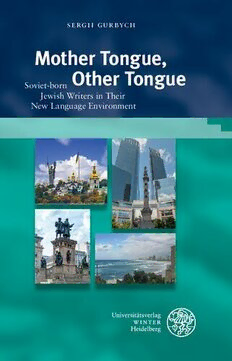
Mother Tongue, Other Tongue: Soviet-Born Jewish Writers in Their New Language Environment PDF
Preview Mother Tongue, Other Tongue: Soviet-Born Jewish Writers in Their New Language Environment
sergii gurbych Mother Tongue, Other Tongue g Soviet-born u r b Jewish Writers in Their gurbych y c New Language Environment Mother Tongue, Other Tongue h he book examines the works of authors – e. g. Katja Petrowskaja, Alex Epstein, Alona Kimhi, Gary Shteyngart and Lara Vapnyar – who, after M immigration from post-Soviet countries, created o fiction in the language of their host countries t h ( Germany, Israel, United States). Considering the e works of these writers, the study focuses on the r elements of cultural identity and analyzes ways of T o transmitting the cultural codes of the writer’s native n g culture to the reader who was raised in another u culture. Unlike many studies on this topic, the e , author assumes that Soviet, rather than Russian, O culture is the native one for the authors in question. t h After immigration, they develop a hybrid cultural e identity; this allows analyzing their texts in terms r of transculturalism. All novels are viewed in terms T o of the Reader Response Criticism. Within the frame- n work of the transcultural approach, each of the g u authors in question is considered in a certain aspect e that is most characteristic of his or her work. beiträge zur slavischen philologie Herausgegebenvon EdithW.Clowes,TheUniversityofVirginia ChristophGarstka,UniversitätBochum Horst-JürgenGerigk,UniversitätHeidelberg UrsHeftrich,UniversitätHeidelberg AdrianWanner,ThePennsylvaniaStateUniversity Band23 sergii gurbych Mother Tongue, Other Tongue Soviet-born JewishWriters in Their New Language Environment Universitätsverlag winter Heidelberg BibliografischeInformationderDeutschenNationalbibliothek DieDeutscheNationalbibliothekverzeichnetdiesePublikation inderDeutschenNationalbibliografie; detailliertebibliografischeDatensindimInternet überhttp://dnb.d-nb.deabrufbar. Dissertation,UniversitätHeidelberg,2021 Originaltitel:MotherTongue,OtherTongue:Soviet-born JewishWritersinTheirNewLanguageEnvironment. ThistextwaspresentedtotheHochschulefürJüdischeStudien atHeidelbergUniversityasadissertation. Firstadviser:Prof.Dr.AnatFeinberg Secondadviser:Prof.Dr.UrsHeftrich DayofthePhDdefense:22June2021 umschlagbild DariaSemenova,PavelGilbo isbn 978-3-8253-4905-9 DiesesWerkeinschließlichallerseinerTeileisturheberrechtlichgeschützt. JedeVerwertungaußerhalbderengenGrenzendesUrheberrechtsgesetzes istohneZustimmungdesVerlagesunzulässigundstrafbar.Dasgiltins- besonderefürVervielfältigungen,Übersetzungen,Mikroverfilmungenund dieEinspeicherungundVerarbeitunginelektronischenSystemen. ©2021UniversitätsverlagWinterGmbHHeidelberg ImpriméenAllemagne·PrintedinGermany Umschlaggestaltung:KlausBrechtGmbH,Heidelberg Druck:MemmingerMedienCentrum,87700Memmingen Gedrucktaufumweltfreundlichem,chlorfreigebleichtem undalterungsbeständigemPapier DenVerlagerreichenSieimInternetunter: www.winter-verlag.de Table of Contents Acknowledgments.........................................................................................7 Introduction...................................................................................................9 Chapter1.MethodologyandResearchMaterial..........................................21 1.1.ResearchMaterial............................................................................21 1.2.Themainconcepts...........................................................................31 1.2.1.Transculturality........................................................................31 1.2.2.Transculturalismandliterature.................................................34 1.2.3.Transculturalismandtranslingualism......................................38 1.2.4.National,social,andculturalidentity.......................................42 1.2.5.Theimpliedreader...................................................................48 1.3.Thefocusandmethodologyoftheresearch.....................................51 Chapter2.GoingbeyondthenormsinHebrew-languageliterature............55 2.1.Generalbackground.........................................................................55 2.2.BorisZaidman:asociolinguisticanalysisofthenovel....................58 2.3.Micro-narrativesbyAlexEpsteinandthetradition ofliterarynonsense..........................................................................75 2.4.AlonaKimhi’scriticalapproachtotheconcept ofsocialandculturalnorms.............................................................91 2.4.1.BiographyandgeneraloverviewofKimhi’soeuvre................91 2.4.2.NightmarePoem......................................................................95 2.4.3.WeepingSusannah.................................................................100 2.4.4.LilylaTigresse.......................................................................107 Chapter3.English-languageimmigrantliterature: Overcomingethnicstereotypes................................................117 3.1.Generalbackground.......................................................................117 3.2.LaraVapnyar:AnimmigrantbetweenthePastandthePresent....123 3.3.GaryShteyngart:mockingculturalstereotypes.............................129 3.3.1.TheRussianDebutante’sHandbook......................................133 3.3.2.Absurdistan............................................................................140 3.3.3.SuperSadTrueLoveStory.....................................................146 Chapter4.InterweavingofculturalcodesinGermanmigrantfiction.......157 4.1.Generalbackground.......................................................................157 4.2.KatjaPetrowskajaandtheconceptofpostmemory.......................167 4.3.OlgaGrjasnowa’scharacters:BetweenJewish andMuslimworlds.........................................................................183 4.4.AlinaBronsky:sociallifeinsideandoutside themigrantneighborhood.............................................................197 Conclusion.................................................................................................209 Bibliography..............................................................................................213 Acknowledgments Thisbookwouldneverhavebeenpossiblewithoutthekindsupportofa number of wonderful people whom I was fortunate enough to meet in mylife.Firstofall,itisFrederekMusallandFrida Schatz, whoopened for me the door to the academic world. Behind this door I met Anat Feinberg, who became for me a guide and advisor in this world, and without whom I would have gotten lost in it like Alice in Wonderland. Thisentirebook,bothitsstyleandcontent,istheresultofherinvaluable advice. Allthatisgoodinthis bookisprimarilyher merit;allthe short- comingsofthisbookstemfromthefactthatIdidnotlistentoheradvice enough. I am grateful to Valeria Sobol and Harriet Murav, who intro- duced me to the world of American Slavic and Jewish studies, and whose moral support has become an invaluable gift for me. Dmitry Tartakovsky and LeiAnna Hamel carefully proofread the text of the book, patiently reading all the additions and revisions that I constantly made. Adrian Wanner, whose articles and books inspired my research, and EdithClowesgavevaluable feedbackand suggestions to mymanu- script so that I could improve the text of this book. Thanks to Urs Heftrich,the publicationofthis book wasnotdelayed for several years; he saved me a lot of the hassle and headaches associated with the pub- lishing process, for which I am infinitely grateful. As for the authors I am considering on the pages of this book, I should thank Olga Grjas- nowa, Katja Petrowskaja, and Alex Epstein, who kindly agreed to an- swer my questions regarding their work and gave me a lot of necessary information. And, finally, I am infinitely grateful to my wife, Daria Semenova, who, despite the enormous workload of her own academic work, was always ready to help me both practically and emotionally, andwhoneversaid“Itoldyouso”whenitturnedoutthattheoptionshe recommendedprovedtobethebestamongalloptions(whichwasprac- ticallyeverytime). Introduction In the past few decades, a significant number of relatively young au- thors,mostlyofJewishorigin,immigratedfromtheformerUSSRtothe Western world, where they achieved recognition and high praise for theircontributiontotheliteratureoftheiradoptedcountries. Sincethese authors chose to write in Hebrew, German or English, they appear to have a peculiar transnational identity, which includes their Soviet cul- tural roots, their Jewish ethnicity, the cultural heritage of their second language, as well as German, American, or Israeli citizenship. The emergenceofthesewritersbecameasignificantculturalphenomenonin the literatures of their host countries, and some of their books became international bestsellers. Following the success of these authors, there has been a significant growth of scholarly interest in the fiction written bypost-Sovietimmigrants,primarilyinGermanyandtheUSA. As Adrian Wanner notes in his study,1 these writers often become involvedinthepeculiarpracticeoftranslatingandinterpretingphenom- enainherenttoaspecificcultureintothelanguageofanotherculture.To some extent, such a writer plays the role of a Native Anthropologist,2 who attempts to explain his own culture to a foreign readership. The writers’ choice of language reflects their intended readership; therefore, aresearchercanidentifytheimpliedrecipientoftheauthor’smessageor 1AdrianWanner,OutofRussia:FictionsofaNewTranslingualDiaspora(Ev- anston,Ill.:NorthwesternUniversityPress,2011),9–10. 2 The concept of Native Anthropologist was introduced in the early 80s, see Emiko Ohnuki-Tierney, “‘Native’ Anthropologists,” American Ethnologist 11, no. 3 (August 1984): 584–86; in the early21st century, it was critically rethought regarding to migration processes in countries of modern Western and Eastern Europe, see Marta Kempny, “Rethinking Native Anthropology: Migration and Auto-Ethnography in the Post-Accession Europe,” Interna- tional Review of Social Research 2, no. 2 (2012): 39–52, https://doi. org/10.1515/irsr-2012-0015.
